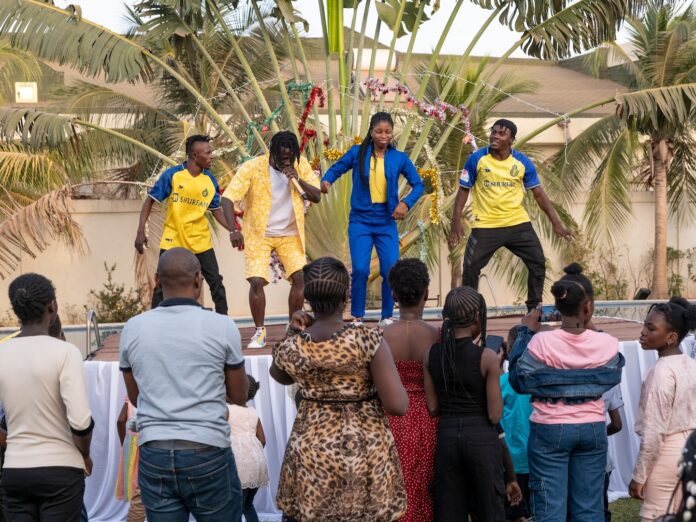Aïcha, wearing a bright yellow T-shirt and blue skirt, looked at the DJ, Dominique Leosgo, smiled and closed her eyes. Then, as the music pulsed, she shook her shoulders, faster and faster. The shimmy would go global.
Clips of her dancing, which Leosgo posted on his TikTok page, collectively got more than 8 million views, turning the pair into a sensation in their West African country and beyond. Aïcha and Leosgo, who goes by DJ Domi, made a music video that got more than 11 million views in four months, making it among the country’s biggest recent hits. They’ve traveled to Chad, Ivory Coast and France and been interviewed with diplomats and journalists. Their second music video, produced by one of Burkina Faso’s top directors, was released this month.
In the once-peaceful nation of Burkina Faso, which has in recent years been besieged by Islamist extremist groups, the pair has become a symbol of resilience and hope. Leosgo and Aïcha — who has no training as a dancer, never went to school and says that she “never, ever expected any of this” — say they are an example of the people’s determination to keep enjoying life, despite the violence.
During a recent week in the capital, Ouagadougou, speakers at a government-sponsored panel on the role of media praised the teenager, boys on bikes chased after her car, and men and women burst into dance when the song started playing at a gas station.
“We don’t want to lecture but to bring joy,” Leosgo said in an interview. “To help people to forget.”
“Hand in hand, we’ll get through this,” Aïcha added. “I am sure.”
Leosgo, 33, made a name for himself traveling the country performing at “bals poussières,” or literally, “dust shows,” a tradition in which artists arrive in often-remote villages with only their cars and their sound systems.
Despite the growing militant violence, Leosgo kept performing, attracting enthusiastic crowds at performances with “no dance floors and no pretty lights.”
On the night Leosgo met Aïcha, he was performing in the village of Sin. Two of Aïcha’s friends, Yacouba and Adama, had paid Leosgo for “atalakou” in which people pay artists to make songs about them. That night, the DJ was singing their names when he noticed Aïcha in her bright yellow outfit, shaking her shoulders. The move is traditional, he said, but he’d never seen someone use it quite like that in response to his music.
“Who’s that girl?” he recalled asking her friends.
“That’s Aïcha,” they responded.
And so the refrain was born: “Yacouba, Adama, Yacouba, Adama … Aïcha, tremblé!”
The clip only went viral months later. Aïcha learned about it when a friend visited her in the peanut field to show her the number of viewers.
Aïcha’s immediate reaction, she recalled with a laugh during an interview, was fear. “I went home and shaved my head,” she said. “I didn’t want people to recognize me.”
But when Leosgo and his manager returned to the village to find Aïcha, she was on board for the music video, and for whatever came next. People in the village used to tell her she was a funny dancer, Aïcha said. “But I always felt at ease when I danced,” she said. “So I kept dancing.”
On a recent evening at one of the city’s fancy hotels, Aïcha and Leosgo were side by side, cracking jokes and dancing. Unlike that night in the village, they were now on an elevated stage, surrounded by massive lights and palm trees, with dozens of hired dancers following their movements.
They’d gotten back from a trip to France about a week before and were filming their second music video. In the six months since the video had gone viral, Aïcha had made her first trip to Ouagadougou, the capital, then moved there. She’d traveled internationally for the first time. She’d started learning French and taking dance courses. She’d gotten a full wardrobe upgrade.
She still stayed in touch with her friends from the village, including Yacouba and Adama. She still liked the same foods. And she still couldn’t quite believe how she’d ended up here.
“For now I want to keep dancing,” she said, sitting near Leosgo and the rest of her team, who she said had become like an adopted family. “But every day has its end. And if God wants me to do something else, then I will.”
David Armel, who directed the second music video, said their story had resonated so much in part because of how humble the pair has remained.
“When people see her, they don’t see a country or an ethnicity,” he said. “When people see her, they just see a Black girl dancing, enjoying herself after a long day of work. And everyone relates to her.”
Onstage, Aïcha wore the same shade of blue and yellow as before, but her worn T-shirt and skirt had been replaced by a snappy blue vest and pants and a bright yellow undershirt. She smiled widely, seeming at ease.
“Move, dance, move, dance,” Leosgo sang, as the dancers below followed.
Everyone was shimmying their shoulders, but no one quite as fast as Aïcha.



